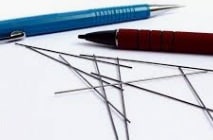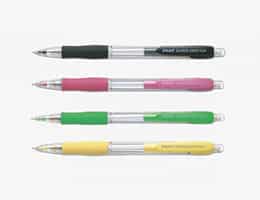 A pencil that has a receptacle to store spare leads is called a mechanical pencil . It is a drawing and writing instrument that can be made of plastic, wood or metal.
A pencil that has a receptacle to store spare leads is called a mechanical pencil . It is a drawing and writing instrument that can be made of plastic, wood or metal.
A lead is a very thin bar of graphite , a black mineral used for creating strokes. In the case of the mechanical pencil, also known as a mine launcher , a pencil , a graph pencil , a pencil-lead , a pen-pencil or a mechanical pencil , it has an opening in its tip that is crossed by the lead. If the lead runs out, this device has a mechanism to facilitate its replacement.
In conventional pencils, when the lead runs out, it is necessary to extract wood from the structure of the instrument using a pencil sharpener . Thus, the pencil shrinks with use. With a mechanical pencil, however, the new lead is propelled through a mechanical action that allows it to be exposed.
Because their tip does not widen with use, mechanical pencils are used by those who need great precision when writing or drawing. There are leads of different diameters that usually range from 0.3 to 2 millimeters , and each pencil model can use leads of a certain diameter.
This precision is the main advantage that mechanical pencils offer over traditional pencils. On the negative side, the leads used in mechanical pencils are usually quite fragile : if the user uses too much force with the mechanical pencil on the blade, the lead is likely to break.
In any case, those who are dedicated to technical drawing usually resort to mechanical pencils due to the characteristics of their line. Engineers and architects are among the professionals who generally prefer this alternative.
As mentioned in a previous paragraph, one of the main differences between a mechanical pencil and a graphite pencil is that the former does not require the use of a pencil sharpener, since its lead is never deformed. This represents not only an increase in precision throughout its use but also an advantage in terms of comfort for the user and, why not, a reduction in waste on the work table.
 Sharpening is a traditional action , which can even represent a ritual for some artists, but we cannot deny that it interrupts the creative process and generates a certain volume of waste that can be annoying if we do not have a basket within our reach. The mechanical pencil is, therefore, a version of the pencil that surpasses it in precision and ease of use ; Of course, graphite is still essential for artists and other people who appreciate its distinctive characteristics, such as the variety of textures and colors.
Sharpening is a traditional action , which can even represent a ritual for some artists, but we cannot deny that it interrupts the creative process and generates a certain volume of waste that can be annoying if we do not have a basket within our reach. The mechanical pencil is, therefore, a version of the pencil that surpasses it in precision and ease of use ; Of course, graphite is still essential for artists and other people who appreciate its distinctive characteristics, such as the variety of textures and colors.
The history of the mechanical pencil takes us to the year 1822, in Great Britain, when Sampson Mordan and John Hawkins patented the first model. Their partnership broke up, and the manufacturing of these pencils was left to Mordan, who had to interrupt his work after a bombing in World War II.
As often happens in these cases, other inventors soon patented their own versions of the mechanical pencil, usually with changes that offered various improvements. Thus, over five decades the public received different models of mechanical pencils. In 1877, those with springs in their mechanism appeared and only in 1895, those with a removable cover to remove the lead.
In addition to the characteristics of its internal parts, the diameter of the mine also changed with decades of innovation, to offer an increasingly greater variety. As a curious fact, the mechanical pencil is especially popular in Japan, where it arrived in 1915 under the name of the eternally sharp pencil .
